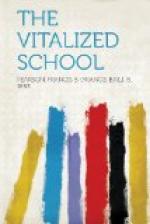QUESTIONS AND EXERCISES
1. Read that chapter of “Tom Sawyer” which deals with the whitewashing episode.
2. What principles of teaching did Tom Sawyer apply?
3. Discuss, from the pupils’ viewpoint, how the study of different subjects may be made a privilege.
4. In accordance with Tom Sawyer pedagogy, discuss plans for the formation of the reading habit in pupils. How direct the pupils’ choice of reading matter?
5. How would you demonstrate to pupils that mental work is more exhausting than manual labor?
6. Why is work a blessing? How convince an indolent pupil of this truth?
7. State the chief problem of the teacher.
8. Show that the pedagogical doctrines of this chapter are not to be classified under the head of “soft pedagogy.”
CHAPTER X
WORDS AND THEIR CONTENT
=Initial statement.=—Life and words are so closely interwoven that we have only to study words with care in order to achieve an apprehension of life. Indeed, education may be defined as the process of enlarging the content of words. No two of us speak the same language even though we use the same words. The schoolboy and the savant speak of education, using the same word, but the boy has only the faintest conception of the meaning of the word as used by the savant. We must know the content of the words that are used before we can understand one another, either in speaking or in writing. For one man, a word is big with meaning; for another, the same word is so small as to be well-nigh meaningless. To the ignorant boor, the word “education” means far less than the three R’s, while to the scholar the word includes languages, ancient and modern, mathematics through many volumes, sciences that analyze the dewdrop, determine the weight of the earth and the distances and movements of the planets, history from the Rosetta Stone to the latest presidential election, and philosophy from Plato to the scholar of to-day.
=The word “education."=—And yet both these men spell and pronounce the word alike. The ignorant man has only the faintest glimmering of the scholar’s meaning of the word when he speaks or writes it. Still the word is in common use, and people who use it are wont to think that their conception of its meaning is universal. If the boor could follow the expansion of the word as it is invested with greater and greater content, he would, in time, understand Aristotle, Shakespeare, Gladstone, and Max Mueller. And, understanding these men, he would come to know philosophy, literature, and language, and so would come to appreciate more fully what education really is. In contemplating the expansion of the word, one might easily visualize the ever widening circle produced by throwing a pebble into a pool; but a better conception would be the expansion of a balloon when it is being inflated. This comparison enables one to realize that education enlarges as a sphere rather than as a circle.




